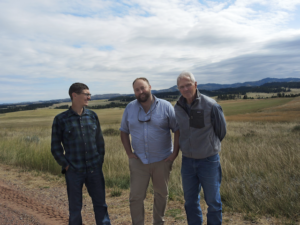By Derf Johnson

MEIC’s Derf Johnson (center) at the Area F site with Earthjustice’s Shiloh Hernandez (left) and former MEIC board member Steve Gilbert (right).
As the world edges ever closer to an irreversible climate meltdown, victories in addressing the climate crisis are more and more essential. Thankfully, our latest victory comes from a federal district court judge in Billings, who found that the U.S. Office of Surface Mining (OSM) failed to adequately evaluate and consider the major environmental impacts associated with a very large expansion of the Rosebud Coal Mine. Rosebud exclusively feeds coal to the Colstrip coal-fired power plant and a small waste coal burning plant just north of Colstrip. The final court decision follows up on a 2022 recommendation from a magistrate judge, who found similar flaws in OSM’s environmental analysis. Broadly speaking, the final ruling by the court finds that OSM failed to consider the impacts of the mine expansion on water resources and the climate.
The immense, sprawling complex known as the Rosebud Coal Mine is jaw-dropping. The footprint is as large as the City of Billings and, over the past several decades, has wreaked havoc on southeastern Montana’s water, wildlife, and climate. The open-pit strip mine has moved systematically across the landscape since the 1970s, targeting, unearthing, and mining the highest value, shallowest coal to feed the adjacent Colstrip plant complex. Five decades of damage (perhaps longer, due to historic mining before Colstrip was even constructed) from the Rosebud Mine is easily visible on Google Maps and will take centuries or millennia for the land to heal, if it ever does. While coal companies and the DEQ like to crow through glossy brochures and promotional videos about the efficacy of reclamation and revegetation programs, in truth the land can never really be restored, especially water systems and the hydrologic balance.
The landscape of “Area F” is some of the most beautiful country in southeastern Montana. Located west/northwest of the town of Colstrip, it is primarily an agricultural landscape with tight, narrow draws interspersed by agricultural fields, intermittent water sources, and an abundance of wildlife. Until recently, it has not suffered the remolding into an industrial landscape that has beleaguered other mined-out areas. But even with active litigation against the expansion, the mine is now encroaching into Area F and stripping out coal. If allowed to fully expand, the mine would impact an additional 6,500 acres in Area F (more than 10 square miles) and remove 70 million tons of coal. When burned, this amount would result in over 100 million tons of greenhouse gas pollution.
Thankfully, the judge noted several inadequacies in the environmental review associated with the expansion. For instance, OSM focused almost exclusively on the economic benefits associated with the mine expansion, such as royalties and payroll benefits, while failing to include the environmental costs, such as increased carbon pollution and its undisputed impacts on society. The analysis also failed to account for the large volume of water that is sucked from the Yellowstone River every day in order to continue operating the Colstrip plant’s cooling system and pollution control machinery, as well as the cumulative impacts associated with continuing to mine in a heavily impacted watershed.
Because using coal for electricity causes a great deal of irreparable harm, and because cleaner alternatives are now more affordable than coal, this ruling could not have come at a more opportune time to have a discussion about the ongoing transition to clean energy. Coal has now shrunk to 20% of the U.S. electricity mix, down from a high of over 50% two decades ago. The Colstrip plant’s days are numbered, with two of the four units already retired, and the other two with a precarious future. Which begs the question: why are we continuing to permit coal mine expansions, with enormous economic and environmental consequences, when the industry is undoubtedly phasing out, both across the world and here in Montana?
MEIC will defend this victory and assure that it sets a strong precedent for other expansions the government considers permitting. Shiloh Hernandez of Earthjustice and Melissa Hornbein of the Western Environmental Law Center both deserve kudos for the serious time and effort in bringing this victory to fruition.
This article was published in the Dec. 2022 issue of Down To Earth.

